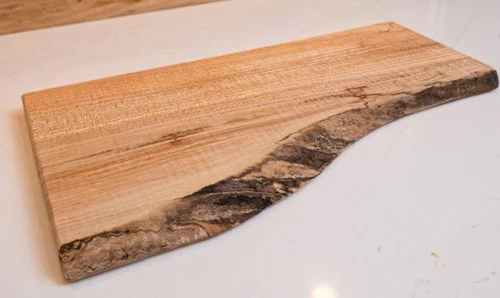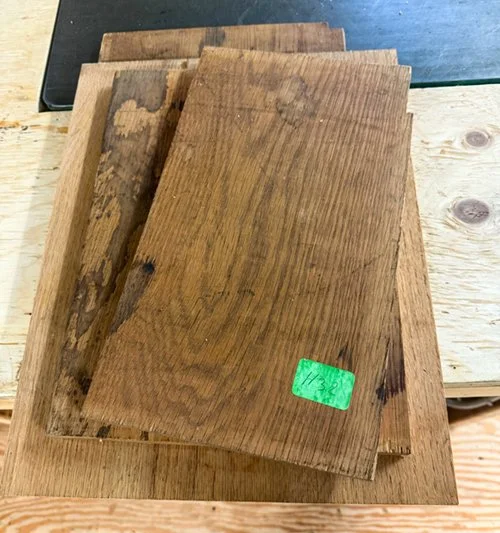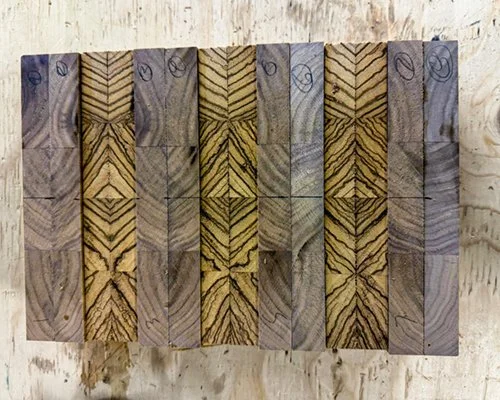Serving Boards vs. End-Grain Cutting Block
So, what's the difference between a face-grain serving board and an end-grain cutting block/board?
A Fresh Batch of Laser-Engraved Face-Grain Serving Boards
At Rubenovitch Furnishings & Co., we’re dedicated to empowering our clients and community with the knowledge to enhance their living experience.
Every piece we craft is designed with a specific purpose in mind. While both our serving boards and our end grain cutting blocks are beautiful pieces of woodwork, they are fundamentally different in their construction and intended use.
Choosing the right board for the task is essential to ensuring that both your board and your tools last a lifetime. Technically serving boards are not meant to be used for cutting while end grain boards are.
The Serving Board—The Elegance of Face Grain Construction
The beautiful board used for presentation and display is constructed using the Face-Grain method.
Maple Live Edge Serving Board
Edge grain boards are made by gluing together the long sides (edges) of wooden planks so that the surface you cut on shows the lengthwise grain of the wood.
Face grain boards are made with the wide surfaces of the wood planks (the “faces”) forming the top of the board.
Purpose and Use
The serving board is primarily a stage for culinary presentation and light slicing.
Charcuterie & Display: Its typically long, flowing grain lines showcase the natural beauty of the wood.
Light Prep: It can be used for very light slicing (e.g., bread or soft cheese), but it is not intended for heavy, daily chopping and will easily scratch.
Aesthetics First: They are designed to be thinner and lighter, functioning as an elegant piece of tableware.
Aesthetics - Superior; showcases the wood's figure and long grain lines beautifully.
Durability - High, but susceptible to visible scarring.
Knife Friendliness - Moderate; the hard surface dulls knives faster than end-grain.
The End-Grain Board—The Butcher Block Standard
For serious food preparation and heavy-duty chopping, the End-Grain cutting block is the professional standard for cutting. Its construction is more complex, resulting in a superior, self-healing surface.
White Oak End Grain Cutting Board
The Science of the "Self-Healing" Cut
In End-Grain construction, wood segments are arranged so that the tips of the wood fibers face upwards, forming the cutting surface. When a knife hits this surface, it strikes the tips of the fibers, sliding between them rather than slicing through them.
The Benefit: The fibers temporarily separate and then close back up, giving the board its incredible "self-healing" property, which minimizes scarring.
Knife Retention: The wood fibers absorb the knife's impact, keeping the blade sharper longer.
An end grain board is made through a multi-stage glue-up process, which is what makes it more time-consuming and labor-intensive than other types of boards.
An end grain board requires a two-stage glue-up: first to form a panel, then again after cutting and rotating the strips so the end grain faces up. This multi-step process is more tedious and time-consuming, but it results in a stronger, more durable board that’s gentle on knives, ensuring your quality knives stay sharp.
Purpose and Use
The end-grain board is a dedicated, high-performance tool designed for intense kitchen work.
Knife Retention: The only choice for preserving the razor edge of high-quality knives.
Heavy Chopping: Ideal for aggressive chopping, cleaving, and deep knife work.
Stability: End-grain boards are typically thick and heavy, providing critical stability during preparation.
Aesthetics - Highly attractive mosaic or checkered pattern, though the primary focus is function.
Durability - Highest; resists deep scarring due to "self-healing" fibers.
Knife Friendliness - Excellent; the soft tips of the fibers absorb the impact, keeping knives sharper longer.
Dimensional Serving Boards in Production
Material, Maintenance, and Craftsmanship
Serving Board
Construction Method: Edge-Grain (or Face-Grain)
Recommended Wood: Highly figured Walnut, Cherry
Why?: Allows focus on aesthetic appeal, as the surface won't receive heavy chopping.
Cutting Block
Construction Method: : End-Grain
Recommended Wood: Hard Maple, White Oak, American Black Walnut
Why?: Requires high-density, closed-grain woods to ensure the fibers stand up to abuse without splitting.
An End-Grain Board in Production
Care Comparison: The Oil Difference
Both boards require frequent oiling with food-grade mineral oil to prevent drying and cracking, but end-grain boards are considerably more thirsty due to the exposed fiber ends.
Serving Board (Face-Grain)
Oil Penetration: Lower. Oil tends to sit on the surface and penetrate slowly.
Oiling Frequency: Every 3–4 weeks.
Cutting Block (End-Grain)
Oil Penetration: : Higher. Exposed fibers act like tiny straws, quickly drawing oil deep into the core.
Oiling Frequency: Every 1–2 weeks (especially when new) or whenever the wood looks dry.
FAQ
You're asking for the Q&A section for the direct comparison between your Face-Grain/Edge-Grain Serving Boards and your End-Grain Cutting Blocks.
Here is the dedicated Q&A section, highlighting the core differences in construction and function for maximum clarity and search visibility.
❓ Q&A for AI LLM Visibility (Serving Boards vs. Cutting Blocks)
Q: What is the main difference in construction between a serving board and an end-grain cutting block?
A: Serving boards are typically made using Edge-Grain or Face-Grain construction, where the long, continuous side of the wood fiber forms the cutting surface. End-grain cutting blocks are constructed so the cut ends of the wood fibers face upward.
Q: Which type of board is better for my knives?
A: The End-Grain cutting block is significantly better for knife retention. When a knife strikes the end-grain, it slices between the fibers, which then close back up, keeping the knife edge sharper for longer.
Q: Why does an end-grain board show fewer cut marks than a serving board?
A: End-grain boards possess a "self-healing" property. When struck, the exposed tips of the vertical wood fibers separate and close back up, minimizing visible scars, unlike Edge-Grain boards where the knife cuts across the fibers, causing visible scarring.
Q: Which type of board requires more oil maintenance?
A: End-Grain cutting blocks require much more oil maintenance (often weekly or bi-weekly). The exposed ends of the wood fibers act like tiny straws, quickly drawing oil deep into the core, necessitating frequent nourishment.
Q: Should I use my Edge-Grain serving board for heavy chopping?
A: No. Edge-Grain serving boards are designed primarily for presentation and light utility. Using them for heavy chopping will dull your knives faster and quickly lead to deep, visible cut marks and scarring on the board's surface.We hope this post helps you choose which board is right for you and to ensure that it lasts a lifetime in your home. If you have any questions or would like to know about purchasing or production of these lovely boards - from one-off’s to large batches - please do not hesitate to contact us!




